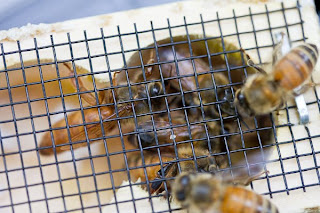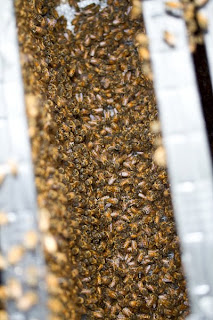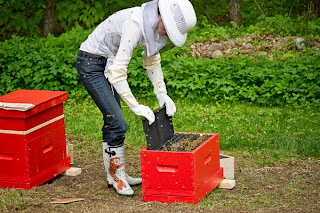 This is what a package of bees looks like. There is a wooden frame with wire screen sides. The queen is in a separate cage at the top center; the bees tend to huddle around her.
This is what a package of bees looks like. There is a wooden frame with wire screen sides. The queen is in a separate cage at the top center; the bees tend to huddle around her.I had prepared a sugar syrup for them the night before: In a 1:1 ratio, I mixed 6 pounds of sugar with water and heated it up to dissolve the crystals. Before getting the bees into their hives, I poured the syrup into my hive-top feeders.
 This is one of my hive-top feeders. There is an ingenious damming mechanism that allows the bees to climb into the box and feed without drowning themselves in the syrup.
This is one of my hive-top feeders. There is an ingenious damming mechanism that allows the bees to climb into the box and feed without drowning themselves in the syrup.
 I lined up my other tools as well: a pair of pliers, for prying out
I lined up my other tools as well: a pair of pliers, for prying outthe syrup can; a nail for making a hole in the candy plugging the
queen cage; and an all-purpose hive tool for getting the lid
off the package and lifting out the queen cage.
There were just two steps of preparation left before I released the bees. First, I pushed an entrance reducer into the hive opening, which makes the door smaller and thus easier to defend against other groups of bees that might try to exploit the weakness of the new colony and rob the hive. Then I opened the hive body and removed the center frames, leaving a hollow space that I would literally pour the bees into.
 I have eight-frame hives rather than the standard ten-frame
I have eight-frame hives rather than the standard ten-framein order to make lifting them a little bit easier. When hives are
full of honey, they can be quite heavy. I removed the center
four frames to create a well in which to pour the bees.

 The queen is the large bee at the far left. You can tell her apart because
The queen is the large bee at the far left. You can tell her apart becauseshe's bigger than the others and her abdomen doesn't have stripes.
She's packed in her cage with some other bees, who tend to
her needs and offer live cushioning during bumpy travels.
Next I peel back the metal disk that conceals an entrance plugged with a soft sugar candy. The queen's retinue will eat their way through the candy so they can join the hive, but to give them a little help, you push a nail through to start a hole.


 Since I've only peeled the disk back halfway, I can still use it
Since I've only peeled the disk back halfway, I can still use itto hang the queen cage from two of the hive frames.
So far there haven't been a lot of bees flying around, but the next step is when it starts to heat up. Once you pull the can out of the package, the air will be thick with bees, and you have to work fast.
 Then I lifted the package . . .
Then I lifted the package . . . . . . and gave it a good slam to loosen
. . . and gave it a good slam to loosenthe bees' hold on the cage.
 Up they go as the lid flies off . . .
Up they go as the lid flies off . . . . . . and I pour them into the hive body.
. . . and I pour them into the hive body.
 After a second slam and pour, I've got most of them either
After a second slam and pour, I've got most of them eitherin the hive or in the air. I prop the box near the hive entrance
to make it easy for the stragglers to find their way in.
 I replace the frames in the hive very carefully
I replace the frames in the hive very carefullyand slowly so I don't crush a lot of bees.
Mission accomplished. I layer on the feeder box and the hive covers, and leave the bees alone for a week to sort themselves out. My husband Mars spent the rest of the day putting up an electric fence to keep out bears and skunks. I'll give you an update after I check them over the weekend. Hopefully, the queen of each hive is out and the bees are hard at work building comb. I see them every day coming and going with a great sense of purpose, so that's a good sign!
Alethea Morrison, Creative Director
Photos by Mars Vilaubi
Special thanks again to Tony Pisano for letting me have a practice run
Alethea Morrison, Creative Director
Photos by Mars Vilaubi
Special thanks again to Tony Pisano for letting me have a practice run



1 comment:
Beekeeping is absolutely fascinating to me. Thanks for posting this!!
-Jenny Halteman
Jigsaw Indexing
http://www.jigsawindexing.com
Post a Comment